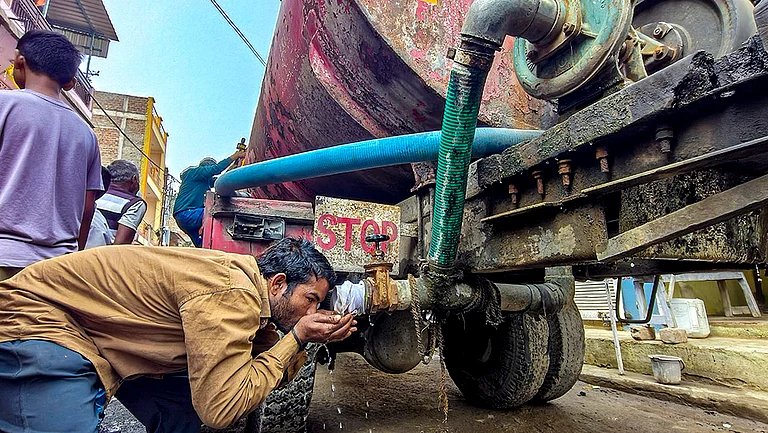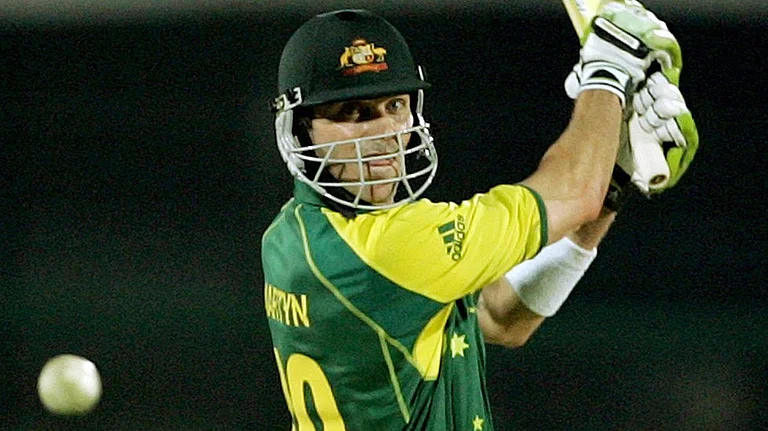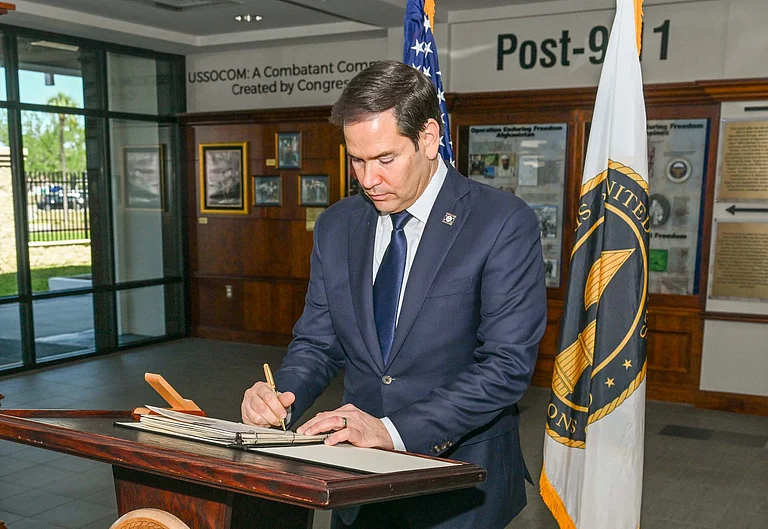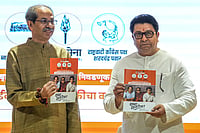On a pleasurably nippy Sunday morning in February, a group of middle-aged residents stand in front of a school gate in Gandhinagar, a residential colony in South Chennai. The leader, a chartered accountant by profession, brings out a yellowed book studded with photos and explains: “Four decades ago, this school auditorium used to host the cultural events of this area every weekend,” and goes on to list the celebrity actors who had performed there.
Three Sundays earlier, another group of curious Chennaiites had ambled along Luz Church Road in Mylapore, listening with rapt attention as a marketing professional-turned-entrepreneur strung together the names of legal luminaries who used to stay in the area. By a singular coincidence, as if united by a common purpose, all of them had helped writing the nation’s constitution. “Though he never lived here, even Ambedkar used to stay at a friend’s place close by during his visits to Madras,” he recalled.
The aforementioned groups aren’t aberrations—they simply illustrate Chennai’s growing affinity for peeks into its past through heritage walks. It was pioneered by entrepreneur Sriram V., who led music lovers in the first heritage walk through the bylanes of Mylapore in 1999, using his deep knowledge of Carnatic music to show them houses where musicians—past and present—lived. Anecdotes, funny and poignant, from the maestros’ lives enlivened the experience.
“The first walk gave me the confidence that Chennai was yearning for more such heritage walks. I started doing one every December during the music season and now I do one every month on different subjects,” explains Sriram, who also co-edits Madras Musings, a magazine on Chennai’s history. Sriram has a knack of conjuring a walk around any interesting context. So when he discovered that Rajaji, D.D. Deshmukh, K. Santhanam, Alladi Krishaswamy Aiyar and O.V. Alagesan—all shapers of the constitution—had lived down the Luz Church Road, he curated the Constitution Walk during this Republic Day.
When demonetisation struck the citizenry like a bolt of lightening, Sriram was leading a band of eager walkers down Mint Street, in north Chennai, where the British government had located its Mint in 1830. “The presence of the Mint also saw communities involved in currency exchange—Shroffs, Arya Vaishyas, Komitti Chettys and Marwaris—settle there, spreading their cultural influence over a century. British governor G.M. Pitt’s attempt to demonetise the old coins with MM Pagoda coins misfired so badly that the Shroffs had to melt the new coins to re-mint the old ones,” Sriram recalls with a chuckle.
Such heritage walks took their rightful place on the itineraries of the packed weeklong celebration of Madras Day every August. “During last year’s Madras Day, there were nearly two dozen walks, organised by locals who tapped senior citizens for information about their localities,” points out Vincent D’Souza, editor of Mylapore Times and a founder of Madras Day celebrations. Vincent, who organises walks in Fort St. George—the seat of power from the British era till date—says people want to know more than what a ‘tourist-guide’ would offer. To ensure that there are informed people to anchor such walks, he is now training a few history majors of Stella Maris College on preparing for such walks.
Though Sriram remains the numero UNO organiser of heritage walks—he has done over 60 such walks, invariably enriching them with talks—others have been quick to follow. Like Sukumar the CA, who needed little preparation when, in 2013, he put together his first walk around Gandhinagar, the first organised residential colony in Chennai. Having been born, brought up and lived there—in all, over six decades—he knew about every bungalow and its occupant. He can reel out a stream of lively nuggets, like how yesteryear movie star B. Saroja Devi learnt to cycle on the shaded avenues of the colony, or how S. Venkataraghavan used to play on the local cricket ground once. “While most bungalows have given way to apartments, there are tales that successive generations want to hear. That is why the Gandhinagar walk is in its fifth edition,” says Sukumar. The walks are also used to spread messages on rain water harvesting and the importance of maintaining a shallow well.
As a cultural experience, too, the walks have evolved. Documentary film-maker S. Anwar has showcased the rich tapestry of Islamic influence through his Nawab Wallajah Trails through Triplicane. “While researching on Muslim monuments of Mount Road I discovered that the Indian Union Muslim League was founded in the Rajaji Hall (where Jayalalithaa’s body lay in state). There are a lot more areas steeped in history and we would unravel it during the coming years,” he says.
Corporate honcho and historian Pradeep Chakravarthy’s heritage walks concentrate on temples and how they influenced Tamil society. “While exploring a temple’s history, I concentrate on its behaviourist influences on society. So the theme on Mylapore’s famous Kapaleeshwarar temple was about the mutually supportive roles played by religion and politics in its history. While doing a tour of Parthasarathy Temple in Triplicane, I explored how even gods have their own popularity charts,” he says, remembering how for his first walk 12 years ago, 30 people enrolled, 15 promised to come and only nine showed up. “Today, at least 30 show up and remain glued to the group till the end,” he points out.
Lawyer N.L. Rajah organises his walks through the Madras High Court campus, telling tales about judges, judgments and scintillating courthouse battles, even while exploring the historicity of the Indo-Saracenic architecture of the sprawling complex. In December, Kalakshetra organises its own walks—the stories surrounding founder Rukmini Arundale and the cultural ambience she created attract visitors from across India and beyond.
Sriram also took the walks outside Chennai, to Thiruvaiyaru, a hallowed ground of Carnatic music; to Madurai, where the walk wound its way around the home of M.S. Subbulakshmi; to Kancheepuram and to the awe-inspiring Gingee fort (in Villupuram district). Though he charges for the walks, Sriram makes sure it only just covers expenses. Having done his schooling in Calcutta, he already has 24 eager enthusiasts raring to go for a walk through Calcutta during this year’s Durga Puja. “As long as you have an interested audience that wants to unpeel layers of the past, this genre would continue to thrive and even diversify,” he predicts.
Diversify it already has. Green enthusiast Shobha Menon has her Tree Walk, “Poochi” Venkat has come up with an INSect walk, Sridhar Venkatram has a food walk and Ramanujar Moulana has a cycle heritage tour. Sriram recollects how matches have been made during his walks. “One marriage even got unmade I think,” he laughs. One couple even celeberated their first wedding anniversary on his midnight tour of Georgetown—the beating heart of old Madras—themed on ‘Murders, graveyards, dacoities and thefts’, retreading the footsteps of sensational crimes, now consigned to oblivion.
“Heritage walks are not only about discovering your city and your neighbourhood. It is a form of self-expression too. The experience makes you an instant expert, something you can broadcast during your talks or on your social media posts. As long as the walks are conducted by well-researched experts, heritage walks are good for health and your love for the city,” observed V. Ramnarayan, editor of Sruti magazine. Solely by that yardstick, Chennaiites will hardly tire of this favourite avocation of theirs in the near future.
By G.C. Shekhar in Chennai


























